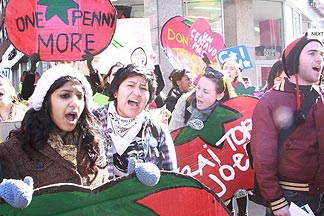 |
|
Sign in the produce section of an Atlanta area Trader Joe’s store
|
In a recent piece for zester.com, entitled “The Profound Impact of a Penny,” Barry Estabrook wrote:
| “Would you pay one penny more per pound to buy a tomato if you knew it would go a long way toward alleviating labor abuse in the fields?
When asked that question, not a single supermarket chain in the country, with the notable exception of Whole Foods Market, said yes. No grocery giant has a legitimate excuse to pinch that extra penny, but of all the holdouts, the most perplexing is Trader Joe’s, which promotes itself as a cheerful bastion of all things ethical…” read more |
Trader Joe’s stubborn refusal to commit — in an enforceable and verifiable agreement — to the Fair Food principles has perplexed many an observer of the Campaign for Fair Food, among them many Trader Joe’s customers, who are disgusted by the company’s inexplicable hard line against collaborating with workers in Immokalee and Florida tomato growers in the Fair Food program.
But now, thanks to its own in-store promotion (above), we may have gained a little more insight into our purportedly ethical friends at Trader Joe’s. As the old saying goes, a picture is worth a thousand words, and the photo above — sent to us from an Atlanta area Trader Joe’s store just yesterday by the ever-vigilant Fair Food activist Emiko Soltis — is no exception.
 The WalMart — and Trader Joe’s — Model: “Bargaining hard for the best prices”…
The WalMart — and Trader Joe’s — Model: “Bargaining hard for the best prices”…
The photo, and the philosophy it proudly touts, place Trader Joe’s squarely in the WalMart camp of supply chain management. In the “WalMart model,” large national chains leverage the combined purchasing power of their hundreds — or thousands — of stores to demand and secure the lowest possible prices for produce. While Trader Joe’s likes to call it “hard bargaining,” in reality it’s the exertion of brute market force, the exploitation of a massively unequal bargaining relationship to demand ever-lower prices.
Sounds like a great deal for the consumer. But the model has a problem: The low prices are in fact artificially low, which is to say that the growers cannot sustain a necessary profit selling their produce for those prices without drastically cutting their own costs. So, inevitably, those cost cuts are ultimately passed on to the weakest link in the supply chain, the farmworker.
In other words, WalMart — and Trader Joe’s — make farmworkers poor by refusing to pay a fair price for the produce they buy. We addressed this issue in our comments prepared for the recent Future of Food conference in Washington, DC:
| “… The retail food giants today – companies like, but not limited to, WalMart — buy tens of millions of pounds of tomatoes a year. At those historically unprecedented volumes, they are buying an ever-bigger share of any single grower’s production and are therefore able to leverage that tremendous market power to demand ever-lower prices from their suppliers.
In 1992, according to USDA statistics, the farm share of the US consumer dollar spent on tomatoes was 40.8%. 40 cents of every dollar spent at the cash register on tomatoes went back to the farmer in 1992. By the end of the decade, that number had fallen to 20.5%. Farms lost fully half of their share of the retail price to the retailers themselves. Yet those farmers, at the same time, are faced with rising input costs for diesel fuel, tractors, land, and pesticides. Caught in this cost/price squeeze, the only place growers can turn to maintain shrinking margins is to labor… Increasingly unequal bargaining relations mean that, when farmers bring their crops to market, the buyers almost always win. And the farmworkers pay the price. In its excellent working paper entitled, “Ending Walmart’s Rural Stranglehold,” the United Food and Commercial Workers quoted none other than John Tyson of Tyson foods who, when confronted by an activist farmer on the untenably low price paid for meat to the farm, said, “Walmart’s the problem. They dictate the price to us and we have no choice but to pay you less.” That exact same dynamic – that exact same unequal bargaining relationship – exists at the next level down the chain, between the farmer, or grower, and his labor. And so the cut in pay is passed along to the last person, the picker, after whom there is no one left to turn to in the chain. As a result, tomato picking piece rates have remained stagnant — and in real terms, wages have steadily fallen — over the past thirty years. This parallels exactly the rise of corporate food giants like WalMart, Kroger, Giant, Stop & Shop, and Publix (Florida’s largest privately held corporation), not to mention the fast-food industry where single chains combine the purchasing power of tens of thousands of restaurants.” read more |
So, while the model may result in slightly lower prices for consumers — as the sign in the photo suggests, the savings are measured in pennies — it also results in the ever-deepening impoverishment of the men and women who toil in this country’s fields to plant, pick, and pack our fruits and vegetables. And the ironic part of the whole sordid business is the fact that, while a penny saved on a pound of tomatoes means virtually nothing to the average consumer, a penny returned to the average farmworker can mean the difference between grinding, desperate poverty and a decent, stable existence.
 Willing to pay the penny? Great! But for how long?…
Willing to pay the penny? Great! But for how long?…
This is where the Trader Joe’s executives reading this post shake their heads and yell at their computers, “But we’ve agreed to pay the extra penny! We just don’t want to sign an agreement…”
And that’s exactly what has Trader Joe’s customers and observers scratching their heads: If the company is willing to pay the penny per pound and require that its suppliers abide by the Fair Food Code of Conduct, as it says it is, why not take the simple step of signing a binding agreement to formalize its promise, as nine other multi-billion dollar companies before it have done?
Now, perhaps, we see the answer to that question: Trader Joe’s, despite its claims to ethical purchasing policies, is in fact deeply committed to the WalMart supply chain model, and that commitment is so strong that, while the company may be willing to violate it temporarily in response to growing public pressure, it will not sign an agreement that binds it to do so on a predictable and enforceable basis.
Which begs the question: Just how long would Trader Joe’s actually pay the extra penny-per-pound?
Most likely answer: Until the protesters go away and the public pressure wanes. And not a minute longer.
And that’s just not acceptable, because there can be no expiration date when it comes to human rights. The Fair Food premium is a necessary and long-overdue adjustment to decades of artificially suppressed farm prices, a return back down the supply chain of just one of many pennies that have been taken, by sheer force, from farmworkers by the retail food companies that purchase the produce they pick.
And that’s why protests will continue — and continue to escalate — at Trader Joe’s stores from Oakland to New York City, until the company takes the crucial, and final step, of signing a true and abiding commitment to the principles of Fair Food.
It’s going to be a long, hot summer for Trader Joe’s. And that’s one thing farmworkers know all too well — long, hot summers…
